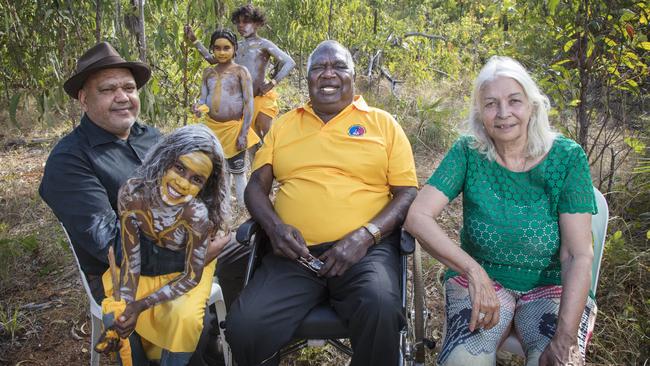‘Feel-good’ SMH goes missing
Why are some quiet when the debate over an Aboriginal voice gets serious?

The mainstream media’s coverage of indigenous issues also sits in three streams.
The symbolic approach is prominent at Nine Entertainment’s newspapers and the ABC. It sees our history as a legacy of shame and advocates constitutional change as a moral statement of white virtue. A more centrist view — prominent at this paper — recognises many Aboriginal Australians are struggling and need a hand up from those doing better. Finally there are those in the media who reject constitutional change because they believe the proposals to date would be racist as they would apply only to a group based on race.
How do these play out in reporting? Coverage of this year’s annual Garma festival at Arnhem Land from August 2 to 4 provided an insight. The Sydney Morning Herald, the national print champion of feel-good journalism, covered Garma on Saturday, August 3, with a page 20 story by David Crowe based on a briefing about Labor leader Anthony Albanese’s support for an Aboriginal voice to parliament. The voice proposal came from the Uluru Statement from the Heart meeting of Aboriginal representatives in May 2017.
Nothing in the Herald that weekend suggested it had actually sent a reporter to Garma. Yet only a few weeks earlier, on Monday, May 27, it had given its entire front page, two news pages and two opinion pages to its launch of its own campaign for Recognition and a voice under a front-page headline “Voice of the heart”.
By the first week of August it was nowhere to be seen when the father of the land rights movement, Yolngu leader Galarrwuy Yunupingu, appeared on the front page of The Australian and proclaimed his people would “throw the nation’s founding document into the sea if change does not come soon”. That day The Australian also devoted most of page five to Garma and ran a page 16 Inquirer opinion piece by the Minister for Indigenous Australians, Ken Wyatt.
The Herald’s News Review section carried two pieces on indigenous issues, one about Aboriginal fashion designers and one by Stan Grant on the new Adam Goodes documentary.
Media opponents of the voice are well represented in the News Corp tabloids and on Sky News. Interestingly, both cover indigenous issues in remote Australia seriously and both covered Garma.
Paul Murray, Peta Credlin and Andrew Bolt, all sceptical of the voice, regularly devote portions of their programs to indigenous issues. The network’s coverage of Garma was good. Northern Territory correspondent Matt Cunningham, a former editor of the NT News, regularly covers indigenous disadvantage, child abuse and alcohol and drug dependence.
While this paper has long supported reconciliation, it too publishes a variety of views and much news from regional Australia.
The initial thinking about an alternative Aboriginal voice was fleshed out in these pages by Pearson, conservative constitutional lawyer and Australian Catholic University vice-chancellor Greg Craven, and conservative lawyer and federal Liberal MP Julian Leeser. The Australian’s editor-at-large Paul Kelly, a supporter of reconciliation, is sceptical of the voice for political reasons and associate editor Chris Kenny a passionate supporter.
No such pluralism at Nine’s papers or our ABC, where it is hard to find a serious piece recognising the very real political problems with a referendum on indigenous reform.
As wise heads in the Aboriginal leadership recognise, the voice is susceptible to scare campaigns. When Bolt argues the voice is racist because it will give power to one group in society based on race, he signals a powerful negative message. No supporter of constitutional reform wants to see a referendum that fails.
Yet Scott Morrison, who like much of his Coalition’s leadership group opposes the voice, is a canny centrist who knows the best chance for some form of constitutional change lies with a Coalition government, which supported recognition in the Constitution as far back as when John Howard was prime minister. Tony Abbott as prime minister wanted a referendum by 2017, the 50th anniversary of the 1967 Aboriginal referendum.
Morrison has given Wyatt three years to build a case. A lot can change in an electorate that really does not understand what is being proposed, but here are some fundamentals:
● Many in the radical left of the Aboriginal movement do not support the voice or the Yolngu idea of makarrata — a truth-telling commission. They want to amend the Constitution to include an anti-discrimination power and recognition of prior indigenous occupation. They favour treaties that inevitably will end in compensation cases. Conservative lawyers who support reform do not favour a substantive rewrite of our founding document because of possible unintended consequences.
● Saying laws should not be created on the basis of race sounds good — but only when you don’t understand the legalities. The Constitution originally included a race power in section 51 (xxvi) that allowed the commonwealth to override the states in taking action on racial minorities “other than the Aboriginal race in any state”. Those words were struck out in the 1967 referendum. A proposed update was put to the government in 2012 that the section be replaced by section 51A and section 116A. Between them these would allow the making of laws in the interests of indigenous Australians, recognise Aborigines as Australia’s first people and prohibit race discrimination or the making of laws under section 51 not for the benefit of indigenous people. The High Court has already recognised a form of land title based only on race in the Wik and Mabo decisions.
● Building a campaign for reform on no more than trying to make mainstream Australia feel guilty for the abuses of past generations will fail just as the Sorry Walk across the Sydney Harbour Bridge failed in 2000. Many Australians will not accept blame for past policies of the 19th and 20th centuries.
● Critics of reform should not imagine Aboriginal Australians will give up their aspirations lest the nation be “divided by race”. The history of rights movements from the suffragettes to gay marriage shows advocates never surrender. In issues of privilege, Australia is already divided by race. On measures from life expectancy to infant mortality, imprisonment, educational attainment, addiction and domestic violence, indigenous people face outcomes wider society would not tolerate.
● The voice would not be a “third chamber” of the parliament, as former prime minister Malcolm Turnbull damned it. But it is vulnerable to such claims. This is why Leeser has suggested the voice be agreed by legislation.
In my view some opposition to the voice could be overcome if advocates were brave enough to co-opt into their plan a suggestion by Warren Mundine in his 2017 pamphlet, Practical Recognition from the Mobs’ Perspective, that communities associated with recognised Aboriginal nations could vote representatives to the voice. This could help sideline noisy self-identifying urban Aboriginal people who receive a disproportionate share of indigenous funding regardless of need. Conservative voters may be better disposed to a body that could make recommendations to confine spending to indigenous people in genuine need.




Aboriginal leader Noel Pearson speaks about the three streams of modern Australia: indigenous Australians, the British settler legacy with its parliamentary institutions and the later waves of migrants from Europe and Asia.